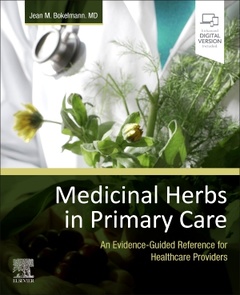Description
Medicinal Herbs in Primary Care
An Evidence-Guided Reference for Healthcare Providers
Author: Bokelmann Jean M.
Language: English
Subjects for Medicinal Herbs in Primary Care:
710 p. · 19x23.4 cm · Paperback
Description
/li>Contents
/li>Biography
/li>
Written specifically for the conventional medical healthcare provider, Medicinal Herbs in Primary Care forms an integral part of the primary care tool belt. Through a series of system-based disease tables, this unique title provides quick, authoritative guidance for the busy practitioner whose patient is requesting guidance on medicinal herbs. The disease tables are supported by herbal monographs that provide expanded details of the available preclinical and clinical evidence laid out in a system-based sequence. Together with the section on herbal basics, this practical reference contains the information today's medical healthcare providers need to develop familiarity with and confidence in the prescription of medicinal herbs.
- Provides quick answers and evidence-based prescribing guidance for medicinal herbs while also addressing complexities and co-morbidities in patient care.
- Features 48 system-based disease tables that identify herbs based on strength of evidence and indicate the scope of potential benefits for other conditions the patient may have.
- Includes 55 monographs for the most common medicinal herbs, with safety and precaution guidelines, summaries of preclinical and clinical trials, chemical constituents and actions, and prescription options for each.
- Contains an introductory section on the basics of medicinal herbs that dispels common misconceptions regarding herbal medicine.
- Discusses key topics such as herb-drug interactions, and includes information on SARS-COV-2 where appropriate.
- Uses typical medical abbreviations throughout for ease of use, and provides a glossary of terms for non-medical and alternative health care providers.
- Helps conventional medical practitioners partner with patients to determine safe herbal options when appropriate, and ensure safety and efficacy of herbal use.
- Enhanced eBook version included with purchase. Your enhanced eBook allows you to access all of the text, figures, and references from the book on a variety of devices.
PART 1
Part 1: Herbal Basics-The History, Terminology, and Unique Characteristics of Medicinal Herbs
1 THE ANCIENT HISTORY AND MODERN REGULATION OF MEDICINAL HERBS
2 THE HERBAL NICHE IN THE SPECTRUM OF INTEGRATIVE MEDICINE
3 MEDICINAL HERB PREPARATIONS
4 THE CHEMISTRY OF MEDICINAL HERBS
5 MEDICINAL HERB SAFETY
6 MEDICINAL HERB RESEARCH
7 THE PRACTICAL USE OF HERBS FOR COMMON PRIMARY CARE CONDITIONS-THE GOOD, THE BAD, AND THE DRUGLESS
PART 2
Part 2: Disease Tables
Section I: SYSTEM-BASED DISEASES
8 EENT NONINFECTIOUS DISORDERS
9 PULMONARY DISORDERS
10 CARDIOVASCULAR DISORDERS
11 GASTROINTESTINAL DISORDERS
12 NEPHROLOGICAL ANDUROLOGICAL DISORDERS
13 WOMEN'S BREAST AND GENITOURINARY DISORDERS
14 MEN'S GENITOURINARY DISORDERS
15 MUSCULOSKELETAL DISORDERS
16 NEUROLOGICAL DISORDERS
17 PSYCHIATRIC DISORDERS
18 DERMATOLOGICAL DISORDERS
Section II: GENERALIZED SYSTEMIC DISORDERS
19 ENDOCRINE DISORDERS
20 DISORDERS OF VITALITY
21 IMMUNE SYSTEM DISORDERS
22 INFECTIOUS DISEASES
23 HEMATOLOGY AND ONCOLOGY
ART 3
Part 3: Herbal Monographs with References
24 ALOE (ALOE VERA; ALOE BARBARDENSIS)
25 ANDROGRAPHIS (ANDROGRAPHIS PANICULATA)
26 ASHWAGANDHA (WITHANIA SOMNIFERA)
27 ASTRAGALUS (ASTRAGALUS MEMBRANACEUS/PROPINQUUS)
28 BACOPA (BACOPA MONNIERI)
29 BILBERRY (VACCINIUM MYRTILLUS)
30 BLACK COHOSH (ACTAEA RACEMOSA/CIMICIFUGA RACEMOSA)
31 BLACK SEED/NIGELLA/BLACK CUMIN (NIGELLA SATIVA)
32 BURDOCK (ARCTIUM LAPPA)
33 BUTTERBUR (PETASITES HYBRIDUS)
34 CALENDULA (CALENDULA OFFICINALIS)
35 CHAMOMILE, GERMAN (MATRICARIA RECUTITA/CHAMOMILLA) AND CHAMOMILE, ROMAN (CHAMAEMELUM NOBILE)
36 CHASTEBERRY/CHASTE TREE/VITEX (VITEX AGNUS CASTUS)
37 COLEUS (COLEUS FORSKOHLII)
38 CRANBERRY (VACCINIUM MACROCARPON)
39 DANDELION (TARAXACUM OFFICINALE)
40 DONG QUAI (ANGELICA SINENSIS)
41 ECHINACEA (ECHINACEA PURPUREA, ECHINACEA ANGUSTIFOLIA)
42 ELDERBERRY/ELDER BERRY AND FLOWER (SAMBUCUS NIGRA)
43 ELEUTHERO/SIBERIAN GINSENG (ELEUTHEROCOCCUS SENTICOSUS/ACANTHOPANAX SENTICOSUS)
44 FENNEL (FOENICULUM VULGARE)
45 FENUGREEK (TRIGONELLA FOENUMGRAECUM)
46 FRANKINCENSE/BOSWELLIA (BOSWELLIA SERRATA/SACRA/CARTERII)
47 GINGER (ZINGIBER OFFICINALE)
48 GINKGO (GINKGO BILOBA)
49 GINSENGS: ASIAN/KOREAN/CHINESE (PANAX GINSENG) AND AMERICAN (PANAX QUINQUEFOLIUS)
50 GOJI BERRY/WOLFBERRY (LYCIUM BARBARUM)
51 GYMNEMA/GURMAR (GYMNEMA SYLVESTRE)
52 GYNOSTEMMA/JIAOGULAN (GYNOSTEMMA PENTAPHYLLUM)
53 HAWTHORN (CRATAEGUS OXYCANTHA, LAEVIGATA, AND SEVERAL OTHER SPECIES)
54 HOLY BASIL/TULSI (OCIMUM TENUIFLORUM/SANCTUM)
55 HOPS/HOP (HUMULUS LUPULUS)
56 HORSE CHESTNUT (AESCULUS HIPPOCASTANUM)
57 HORSETAIL (EQUISETUM ARVENSE)
58 LEMON BALM (MELISSA OFFICINALIS)
59 LICORICE (GLYCYRRHIZA GLABRA)
60 MACA (LEPIDIUM MEYENII)
61 MILK THISTLE (SILYBUM MARIANUM)
62 MOTHERWORT (LEONURUS CARDIACA)
63 PASSIONFLOWER (PASSIFLORA INCARNATA)
64 PEPPERMINT (MENTHA PIPERITA)
65 RHODIOLA (RHODIOLA ROSEA)
66 SAFFRON (CROCUS SATIVUS)
67 ST. JOHN'S WORT (HYPERICUM PERFORATUM)
68 SAW PALMETTO (SERENOA REPENS)
69 SCHISANDRA/SCHIZANDRA (SCHISANDRA CHINENSIS)
70 SKULLCAP/SCULLCAP (SCUTELLARIA BAICALENSIS, SCUTELLARIA LATERIFLORA)
71 STINGING NETTLE/NETTLES/NETTLE (URTICA DIOICA, URTICA URENS)
72 TRIBULUS (TRIBULUS TERRESTRIS)
73 TURMERIC (CURCUMA LONGA)
74 UMCKALOABO/SOUTH AFRICAN GERANIUM (PELARGONIUM SIDOIDES)
75 UVA URSI/BEARBERRY/KINNIKINIC/BEAR GRAPE (ARCTOSTAPHYLOS UVA-URSI)
76 VALERIAN (VALERIANA OFFICINALIS)
77 YARROW (ACHILLEA MILLEFOLIUM)
APPENDIX I: MEDICAL AND RESEARCH
ABBREVIATIONS
APPENDIX II: BIBLIOGRAPHY AND
ADDITIONAL RESOURCES
Dr. Bokelmann has given presentations and workshops on integrative medicine, herbal medicine, and phyto-aromatherapy at the ISU family medicine residency program, ISU PA program, ISU College of Pharmacy, Idaho Association of Physician Assistants, Alaska Academy of Family Medicine Annual Scientific Congress, National Association for Holistic Aromatherapists, and numerous seminars in Endobiogenic phyto-aromatherapy.

